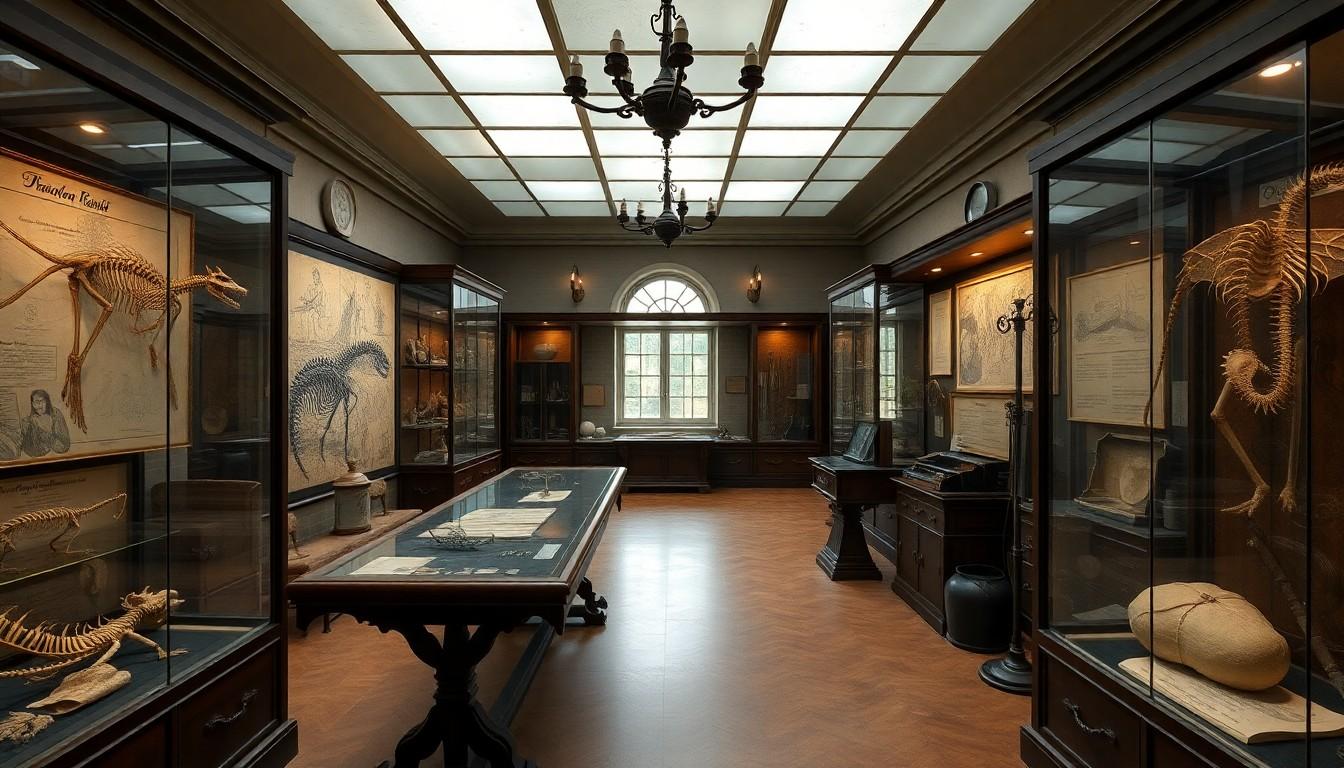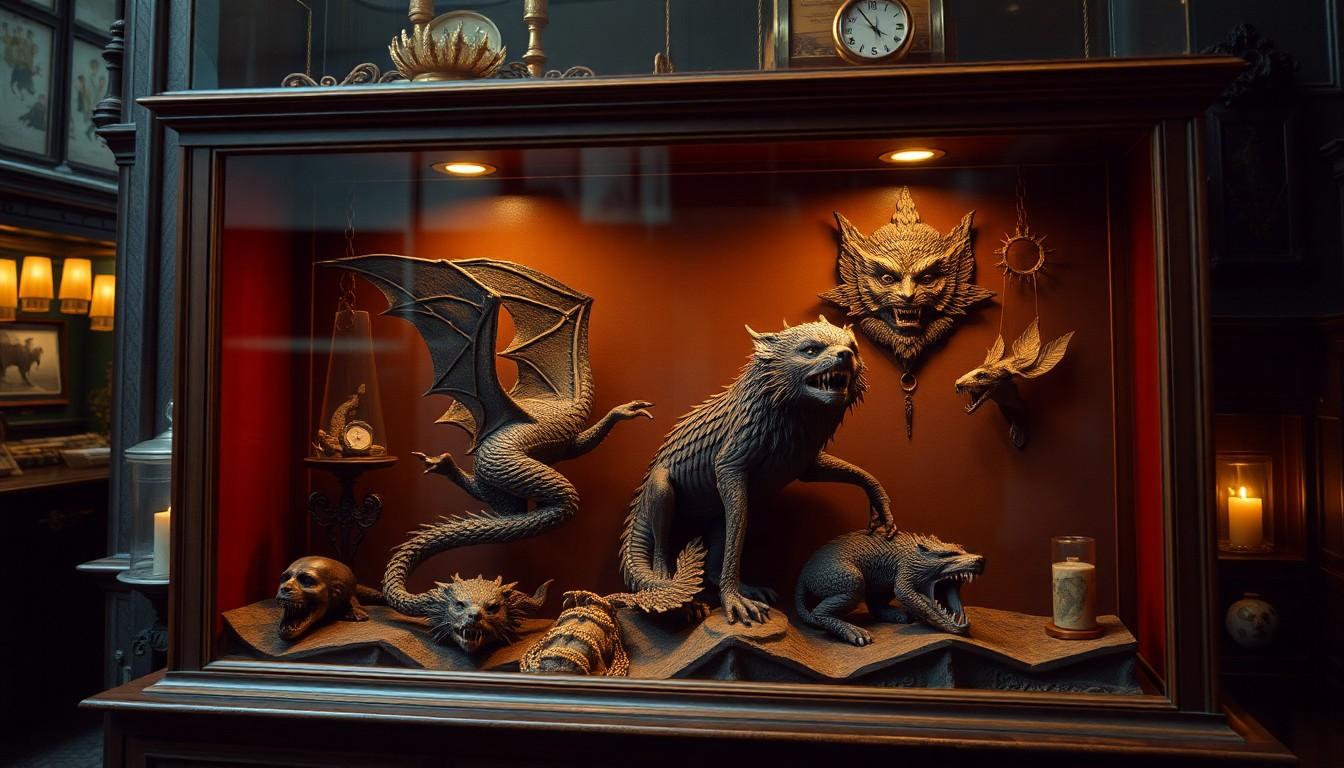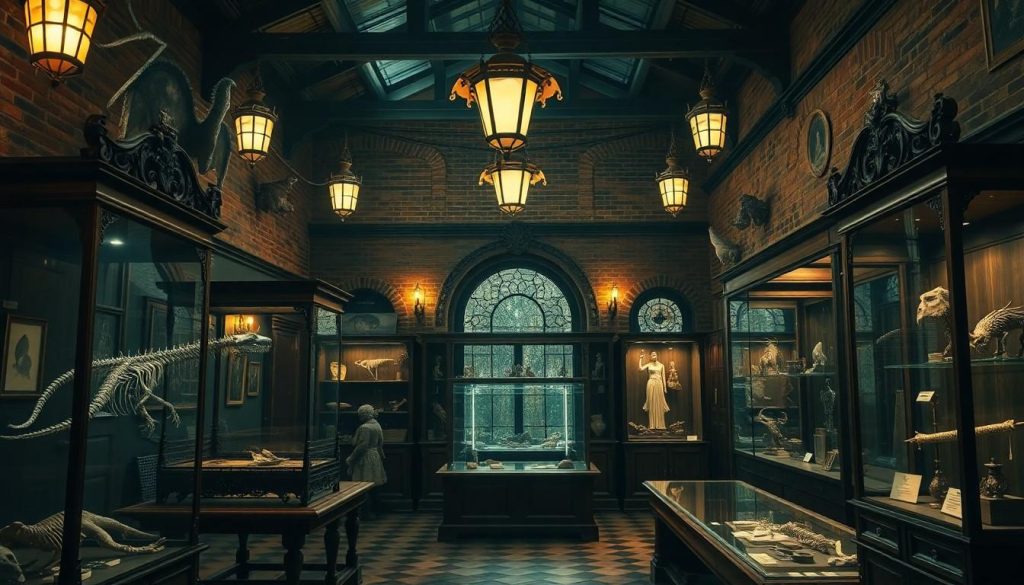Hidden in the heart of London lies a peculiar collection that challenges our understanding of natural history. The Merrylin Cryptid Museum houses an extraordinary assemblage of specimens that blur the line between fact and fiction. From alleged dragon skeletons to preserved fairy remains, this mysterious vault showcases the lifework of crypto-naturalist Thomas Theodore Merrylin.
The museum’s collection dates back to the Victorian era when Merrylin spent decades gathering unusual artifacts and documenting bizarre creatures worldwide. His findings remained sealed in a London basement until their rediscovery in 2006, sparking intense debate within the scientific community. Whether these specimens represent elaborate hoaxes or genuine cryptozoological discoveries, they’ve captured the imagination of visitors and researchers alike.
The Strange Origins of the Merrylin Cryptid Museum
The Merrylin Cryptid Museum is an artistic installation that blends fact with fiction through meticulously crafted specimens. Created by artist Alex CF, this unique museum challenges traditional presentations by immersing visitors in an elaborate narrative of cryptozoological discoveries.
Thomas Merrylin’s Mysterious Collection
The collection centers around Thomas Theodore Merrylin, a fictional crypto-naturalist created by Alex CF. The museum’s artifacts include detailed specimens of:
- Preserved skeletal remains of mythical creatures
- Reconstructed tissue samples of fantastical beings
- Anatomical studies of mermaids fairy specimens
- Dragon skeletal fragments
- Alleged extraterrestrial remains
- Vampire-related artifacts
Historical Significance and Timeline
The museum’s narrative timeline unfolds through several key events:
- 1960s: The supposed discovery of specimens in Merrylin’s mansion basement
- Creation of detailed documentation supporting each specimen
- Establishment of an immersive exhibition space
- Integration of Victorian-era scientific methodologies
- Development of a comprehensive cataloging system
The artistic installation combines elements of:
- Victorian-era scientific practices
- Cryptozoological research methods
- Contemporary museum curation techniques
- Narrative-driven exhibition design
Each exhibit piece reflects Alex CF’s dedication to crafting believable specimens that blur the lines between art installation and fiction.
Notable Exhibits and Artifacts

The Merrylin Cryptid Museum houses an extensive collection of alleged cryptozoological specimens presented in Victorian-era display cases. The exhibits combine preserved remains with detailed scientific documentation to create an immersive experience.
Rare Cryptid Specimens
The museum’s core collection features preserved specimens of mythical creatures, including:
- A complete skeletal structure of Draco alatus presented as evidence of dragon existence
- Preserved remains of Homo vampirus, displayed with tissue samples
- A documented lycanthrope transformation specimen showing alleged human-to-wolf skeletal changes
- Preserved fairy specimens with intact wing structures
- Mermaid anatomical studies with detailed skeletal components
- Gnome remains featuring distinctive morphological characteristics
- Preserved extraterrestrial specimens with unique anatomical features
- Original field notes documenting specimen discoveries
- Victorian-era laboratory equipment used in preservation processes
- Research paraphernalia from expeditions
- Antiquities of unidentified origin with detailed cataloging
- Cthulhu regalia artifacts with accompanying research notes
- Preservation containers featuring period-accurate classification labels
- Detailed anatomical drawings of specimen structures
| Specimen Type | Preservation Method | Documentation Format |
|---|---|---|
| Dragon Remains | Skeletal Assembly | Field Notes & Sketches |
| Vampire Tissue | Chemical Preservation | Laboratory Reports |
| Lycanthrope | Skeletal Display | Transformation Studies |
| Fairy Specimens | Sealed Containers | Anatomical Drawings |
| Ancient Artifacts | Climate Control Cases | Catalog Records |
Controversy and Authenticity Debates

The Merrylin Cryptid Museum faces significant scrutiny regarding the authenticity of its specimens, which include alleged remains of mythical creatures discovered in Thomas Theodore Merrylin’s mansion basement. The controversy centers on the origin and authenticity of these artifacts that challenge conventional scientific understanding.
Scientific Analysis of the Collection
Scientific examination reveals inconsistencies in the biological composition of the museum’s specimens. The preserved remains exhibit characteristics that contradict established physical laws and fundamental principles. Key findings include:
- The skeletal structures display anatomical configurations impossible in known vertebrate evolution
- The preservation methods used on the specimens lack historical documentation
- The genetic material shows no degradation typical of genuine Victorian-era specimens
- The tissue samples demonstrate modern construction techniques rather than natural decomposition patterns
Modern Expert Perspectives
Contemporary researchers maintain a skeptical stance on the museum’s collection authenticity. The analysis points to several factors:
- The specimens bear a striking resemblance to modern artistic creations by Alex CF
- Documentation lacks peer-reviewed verification from established scientific institutions
- Carbon dating results remain unpublished for independent verification
- The specimens demonstrate craftsmanship techniques consistent with contemporary art practices
- No verified chain of custody exists for the alleged Victorian-era discoveries
The museum’s artifacts blend artistic craftsmanship with cryptozoological narrative, challenging traditional boundaries between scientific exhibitions and natural history preservation.
Museum Location and Visiting Information

The Merrylin Cryptid Museum began as a conceptual project envisioned for East London’s cultural district. Alex CF, a London-based illustrator, writer, and sculptor, spearheaded the initiative through an Indiegogo crowdfunding campaign 2014.
Current State of the Collection
The Merrylin Cryptid Museum operated as an alternative history installation from 2006 to 2015. The collection showcased meticulously crafted specimens presented in a scientific context, including:
- Mythical Specimens: Preserved remains of dragons, vampires, werewolves, and faeries
- Display Methods: Victorian-era cases housed the specimens with detailed scientific documentation
- Exhibition Style: Immersive displays combine historical authenticity with supernatural elements
- Presentation Format: Scientific descriptions accompanied each artifact, mimicking natural history museum standards
| Time Period | Status | Location |
|---|---|---|
| 2006-2015 | Active Installation | East London (Planned) |
| 2014 | Crowdfunding Campaign | Online Platform |
| 2015-Present | Non-operational | Not Applicable |
The physical museum never materialized despite the extensive planning and crowdfunding efforts. The collection remains primarily a conceptual art project that blends scientific presentation with fantastical elements, challenging traditional museum exhibition formats.
Legacy and Cultural Impact
The Merrylin Cryptid Museum’s influence extends beyond traditional museum boundaries, creating lasting ripples in artistic and scientific communities. The museum’s unique presentation of cryptozoological specimens sparked debates about the intersection of fact and fiction in natural history exhibitions.
Key cultural contributions include:
- Integration of Victorian scientific aesthetics with contemporary art installations
- Creation of detailed specimen documentation that mirrors authentic museum catalogs
- Development of innovative display techniques for fictional artifacts
- Establishment of new standards for alternative history narratives in museum spaces
The museum’s impact on popular culture manifests through:
- Social Media Engagement
- Generated extensive online discussions about cryptozoology
- Inspired digital art communities to create similar fictional specimens
- Created viral content through detailed specimen photographs
- Academic Interest
- Prompted discussions about museum presentation methods
- Influenced exhibit design in other alternative history installations
- Sparked debates about authenticity in natural history collections
- Artistic Innovation
- Established new benchmarks for prop creation quality
- Advanced techniques for aging artificial specimens
- Demonstrated effective blending of scientific accuracy with fictional elements
| Impact Area | Measurement |
|---|---|
| Exhibition Duration | 2006-2015 |
| Online Reach | Global audience |
| Specimen Types | 200+ unique pieces |
| Documentation | 1,000+ pages |
The project’s legacy continues to influence contemporary artists at the intersection of scientific presentation and creative storytelling. Alex CF’s meticulous attention to detail in crafting specimens and supporting documentation established new standards for alternative history installations.
Conclusion
The Merrylin Cryptid Museum is a testament to the power of artistic imagination and storytelling in the modern world. While its specimens may not be scientifically verified, the museum’s impact on artistic expression and curation techniques is undeniable.
Alex CF’s creation continues to challenge visitors’ perceptions and spark meaningful discussions about the boundaries between fact and fiction. The museum’s legacy lives on through its influence on contemporary artists and its role in redefining how alternative history can be presented in exhibition spaces.
Whether viewed as an elaborate art installation or a thought-provoking commentary on cryptozoology, the Merrylin Cryptid Museum remains a unique cultural touchstone that bridges Victorian-era mystique with modern creative expression.

